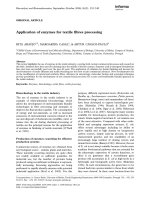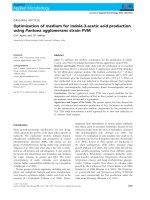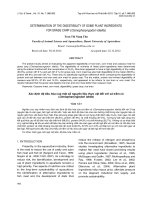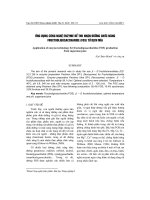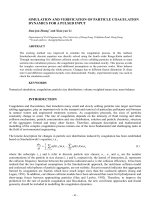Antennas for information super skyways institute of physics publishing feb 2004
Bạn đang xem bản rút gọn của tài liệu. Xem và tải ngay bản đầy đủ của tài liệu tại đây (5.94 MB, 550 trang )
Antennas for Information
Super Skyways:
An Exposition on Outdoor and
Indoor Wireless Antennas
ELECTRONIC & ELECTRICAL ENGINEERING RESEARCH STUDIES
ANTENNAS SERIES
Series Editor: Professor J. R. James
The Royal Military College of Science
(Cranfield University), Shrivenham, Wiltshire, UK
10.
Frequency Selective Surfaces: Analysis and Design
John C. Vardaxoglou
11.
Dielectric Resonator Antennas *
Edited by K. M. Luk and K. W. Leung
12.
Antennas for Information Super Skyways:
An Exposition on Outdoor and Indoor Wireless Antennas
P. S. Neelakanta and R. Chatterjee
* Forthcoming
Antennas for Information
Super Skyways:
An Exposition on Outdoor and
Indoor Wireless Antennas
Perambur S. Neelakanta
and
Rajeswari Chatterjee
RESEARCH STUDIES PRESS LTD.
Baldock, Hertfordshire, England
RESEARCH STUDIES PRESS LTD.
16 Coach House Cloisters, 10 Hitchin Street, Baldock, Hertfordshire, SG7 6AE, England
www.research-studies-press.co.uk
and
Institute of Physics PUBLISHING, Suite 929, The Public Ledger Building,
150 South Independence Mall West, Philadelphia, PA 19106, USA
Copyright © 2003, by Research Studies Press Ltd.
Research Studies Press Ltd
. is a partner imprint with the Institute of Physics PUBLISHING
All rights reserved.
No part of this book may be reproduced by any means, nor transmitted, nor translated
into a machine language without the written permission of the publisher.
Marketing:
Institute of Physics PUBLISHING, Dirac House, Temple Back, Bristol, BS1 6BE, England
www.bookmarkphysics.iop.org
Distribution:
NORTH AMERICA
AIDC, 50 Winter Sport Lane, PO Box 20, Williston, VT 05495-0020, USA
Tel: 1-800 632 0880 or outside USA 1-802 862 0095, Fax: 802 864 7626, E-mail:
UK AND THE REST OF WORLD
Marston Book Services Ltd
, P.O. Box 269, Abingdon, Oxfordshire, OX14 4YN, England
Tel: + 44 (0)1235 465500 Fax: + 44 (0)1235 465555 E-mail:
Library of Congress Cataloguing-in-Publication Data
Neelakanta, Perambur S.
Antennas for information super skyways : an exposition on outdoor and
indoor wireless antennas / Perambur S. Neelakanta and Rajeswari
Chatterjee.
p. cm. (Electronic & electrical engineering research studies.
Antennas series ; 12)
Includes bibliographical references and index.
ISBN 0-86380-267-2 (alk. paper)
1. Antennas (Electronics) I. Chatterjee, Rajeswari, 1922- II. Title.
III. Series.
TK7871.6 .N44 2002
621.384'135 dc21
2002073937
British Library Cataloguing in Publication Data
A catalogue record for this book is available from the British Library.
ISBN 0 86380 267 2
Printed in Great Britain by SRP Ltd., Exeter
Cover artwork by A3 grafix ltd.
v
Editorial Foreword
It is not uncommon for scientific and engineering topics to reflect the trends and
upsurge of practices in society and this has been vividly witnessed with antenna
research and technology during the past three decades. In the late 1960s I recall
the words of a senior colleague “ that antennas had been exhaustively treated and
there was little scope for further innovation ”. Soon after we saw the profound
developments in printed antenna technology, instigated by the onset of integrated
electronics and the need for more compatible compact antennas that are easier to
manufacture. Printed antenna research and development continues to this day
unabated but is now overlaid with exciting developments in mobile base station
and handset antennas, arising from the global expansion of new communications
during the past decade. Even more recently, the old-fashioned word “Wireless”
has been adopted to describe the latest communication trend of seamless
connectivity using direct radiation between terminals, as opposed to guided waves
in wires. Bluetooth, Wireless Local Area Networks (WLAN) systems, etc. are now
almost household names, such is the penetration of these new communication
concepts into society at large. For the antenna community, wireless presents both
new design problems and outstanding opportunities. Every wireless link must have
transmit and receive antennas designed precisely to satisfy both the link system
requirements and the physical demands of a particular terminal; be it a personal
computer, a refrigerator, an ear piece, a petrol pump and so on. Wireless antennas
thus require bespoke individual design and this is an entirely new situation for
equipment planners and suppliers, sales staff, antenna designers and students alike:
antennas cannot be purchased off-the-shelf and each design needs to start afresh.
The outcome is that a wider, and often disparate spectrum of people, now need to
have a better understanding of these antennas at different levels and the present
library stock of general elementary antenna texts on one hand and advanced
research books on the other, needs supplementing with a new type of book: That is,
a text specifically giving a comprehensive insight to a wide community of readers
who are engaged in some way with the new wireless systems. This is the objective
of their new book and Professors Neelakanta and Chatterjee are to be congratulated
on creating such an expansive tutorial text without sacrificing technical depth and
practical engineering content. Professor Neelakanta is well known for his books
and research. Professor Chatterjee has made distinguished contributions to the
profession and has already published in this Series with her notable 1985 book
“Dielectric and Dielectric-loaded Antennas”. Their present new book is an
adventurous and enthusiastic response to the present needs of the antenna
community in general and it is indeed a unique and valuable perspective. It is a
sincere pleasure for me to welcome the authors of this new venture to RSP’s
“Antenna Series”.
Professor Jim R James
December 2002
This page intentionally left blank
vii
Preface
As the world marches along the information superhighway ahead into the first
decade of the new century, the progress and pace of evolving telecommunications
are seen incomprehensibly fast both in the wireline and wireless sectors. Specific
to the panoramic realm of wireless telecommunications and networking (as
conceived now and projected as future interests or “next-generations”) exists a
gamut of standards. These include multiple applications of electrical
communication technology spanning across voice, video, and data transmissions in
an integrated fashion. The associated radiation and propagation of electromagnetic
(EM) energy pose unique considerations as a result of user mobility and
dynamically changing ambient. As a result, the electromagnetics of wireless
transmissions encounter complex interference situations. In order to combat such
signal-impairing constraints and maintain robust wireless links, specific designs at
the interface of the propagating medium (namely, the free-space) and the RF
electronics of the wireless units are warranted. The vital part of this interface refers
to the antenna structures.
The first step towards learning and comprehending antennas — whether in
educating technicians or creating a new breed of wireless communication
engineers is to become proficient and conversant of the past profile of antenna
systems as well as gain a comprehensive knowledge and hands-on perspective
about the emerging EM radiating structures. Therefore, the broad scope of this
book is to offer a comprehensive insight into such antennas. It includes the
feasibility and implementation issues as well as design considerations used in
modern wireless/mobile communication systems.
About this book …
The primary goal of this book, as stated above, is to cast the salient aspects of
wireless communication antenna technology in the real-world perspectives.
Generally speaking, there are three types of books on the subject matter of
antennas: The first category refers to classical books on EM radiating systems
written over the last several decades (but their contents revised and updated to
include the changing trends and evolving new concepts). Such books address the
global prospects of antenna systems and comprehensively project various antenna
types against their suitable applications to radio/TV, radar, navigational aids and
viii
traditional point-to-point communication systems. Detailed analytical
considerations and/or numerical computations form the core theme of these books.
However, they, to a large extent, are not written per se, with a mission to include
exclusively (and exhaustively) modern wireless/mobile communication systems.
The next class of books on antennas contains details focused on
wireless/mobile communication systems with the contents formatted in the style of
a handbook. They are again written to include exhaustively the plethora of
wireless/mobile communication antennas. Multiple authors have contributed
chapterwise contents, each chapter devoted to describe a specific topic. These
books, however, hardly include any theoretical formulations and/or analytical
framework on the various structures of antennas elaborated upon, but they stand as
excellent reference manuals on the subjects of interest.
The third version of books focused exclusively on applications of antennas
for radar, satellite systems, wireless/mobile communications etc. They are written
for an audience who are totally unacquainted with analytical considerations and
have no flair for electromagnetic theory. Hence, intentionally avoided in such
books are the mathematics and plug-in equations pertinent to elecromagnetics,
radiation principles and EM propagation concepts.
The present book is written in a unique perspective to present as its
contents a mix of topics covering both the analytical aspects of antennas (with
their relevance to wireless/mobile communications) as well as descriptions on
underlying principles and design considerations. In essence, this book includes
chapters that supplement the descriptive portrayals of wireless/mobile
communication systems with necessary analytical considerations along with
necessary details on the associated antenna designs.
In writing this book, the authors have duly considered the wide audience
profile that will reach out for this book students and researchers, who pursue
studies on antennas in the orthodox realm of EM field equations; and the technical
staff of the wireless-communication industrial sector who would like to gain a
working knowledge on the state-of-the-art antenna concepts (sans field equations!)
so as to use them in their developmental efforts.
Hence, those sections and/or chapters that are significantly oriented in
projecting analytical perspectives are duly identified (and indicated as footnotes)
for those who may wish to skip them. Care was, however, exercised in formatting
the chapters such that, such selective reading will not dislodge the sequence and/or
understanding the contents in the rest of the book. The layout of the book is as
follows: It is organised in eight chapters. The contents of each chapter are
preceded by a chapter-opener portraying a preview on the real-world aspects and
application considerations pertinent to the chapter. Further, some example-
problems are presented on ad hoc basis within various chapters (with hints and
solutions, as necessary). Lastly, the relevant bibliography is appended at the end of
each chapter. Also included at the end of the book are acronyms and abbreviations
commonly used in wireless communication parlance.
A brief outline of each chapter is indicated below:
ix
Chapter 1
This is an introduction to wireless communications, and it describes the historical
perspectives and evolution of modern wireless/mobile communication systems. It
highlights the state-of-the-art systems, their general specifications and their
functional attributes plus application profiles. This chapter is recommended to all
readers to get a perception on wireless communication systems. It has hardly any
exposé to mathematical principles.
Chapter 2
Here, a summary on the basic concepts of electromagnetic (EM) fields and waves
is presented and the analytical aspects of electromagnetic wave theory are
elaborated. This chapter requires background as well as in depth knowledge of
electromagnetism. Readers who are either already familiar with such topics (or
those who do not relish such mathematics!) may omit reading this chapter.
Chapter 3
This is an extension of Chapter 2 in presenting the underlying concepts of EM
field theory applied to EM radiation, antennas and wave propagation. Again,
considering its heavy mathematical outlay, those who desire so could skip this
chapter. It is however stressed that, both in Chapters 2 and 3, the analytical
presentations are tailored to appreciate the general scope and framework of this
book.
Chapter 4
This chapter is written in two parts: The first part is again a compendium of
analytical results on the basic antenna elements and, the second part is devoted to
describe the selective elements that are widely used in wireless communication
systems. It is recommended that the readers who do not need the first part may
avoid it and proceed to the second part without any loss of generality of their
reading sequel.
Chapter 5
Presented in this chapter are details on antenna arrays, constituted by the antenna
elements described in Chapter 4. The specific uses of such arrays in
wireless/mobile communications are identified. This chapter is a prologue to the
smart antennas described in Chapter 6.
Chapter 6
Addressed here are exclusive considerations on intelligent antenna systems that
combine the basic arrays (described in Chapter 5) and signal-processing
techniques. Designated as “smart antennas”, these structures are viable radiators of
the state-of-the-art wireless communication systems as presented in this chapter.
x
Chapter 7
The indoor RF communication links are part of modern wireless communications.
Typically, the WLAN and the Bluetooth
TM
are examples of such systems. The
antenna requirements of such indoor wireless communication systems are unique
and warrant a distinct study. As such, Chapter 7 is devoted to present all the
relevant topics.
Chapter 8
The trend in modern wireless communications is to support the so-called
broadband transmissions of next-generation (3G) systems. Hence, focused in
Chapter 8, is a study that summarises the antenna aspects of broadband wireless
communication systems. The broadband considerations pertinent to wireless
access networks as well as indoor applications are identified and relevant antenna
requirements are described.
General layout of this book versus audience profile …
This book is written to suit classroom presentations (for adoption as a textbook) as
well as to guide design and development engineers. That is, it outlines the
necessary underlying principles and implementation considerations of wireless
communication antennas in a lucid manner for students, designers, as well as
technical staff involved in development activities. This book is organised to help
students as a companion text and guide design engineers and developmental staff
of the industry on the changing trends in antenna concepts. In a nut-shell, the goal
of the book is to make its audience appreciate the query “Why so many types of
antennas at all?”
For student audience …
With reference to the class room environment, a modern approach to teaching
engineering subjects (as encouraged by various accreditation bodies) refers to
blending design considerations along with the theoretical contents. Hence design
examples of practical interest and implementation are presented explicitly in this
book. That is, the pedagogy of this book is conceived to meet the relevant
objectives consistent with the student audience profile and its requirements. As
stated before, across various chapters, presented are example-problems as well as
some typical problems that are left as exercises to the readers. Should this book be
adopted as a textbook, such exercises will be very useful. Where needed, some
hints are indicated underneath the problem-statements.
The authors’ vast experience as instructors of antennas-related courses
provides insight into the students’ needs on this subject leading to making this
book student-friendly. This book will be ideal for a postgraduate and/or
undergraduate elective course such as “Antennas and Propagation Aspects of
xi
Modern RF/Wireless Communication Systems”, which will attract a large
enrollment in many universities.
For antenna researchers, designers and development staff …
In the industrial perspective, as indicated above, this book is intended to serve as a
companion reference to researchers on “the cutting edge” aspects of wireless
antenna systems and as a guide to the technical staff involved in the design,
fabrication and testing of wireless communication antennas.
Wireless communication antennas are an exclusive subset of the traditional
electromagnetic radiators. These antennas should be viewed for their applications
tailored to meet specific performance aspects of wireless/mobile communication
links that are beset by low-power transmissions through hostile, inference-prone
settings. Their physical size becomes of utmost importance in view of the
compactness and low visibility considerations attached to their applications in
portable units. Further, the physical orientation of these antennas in portable units
should be duly recognised in the design as well as in evaluating the overall
performance. In addition, the polarisation considerations are also issues of
concern.
As such, even for those who are familiar with antenna theory, the design
perspectives of wireless/mobile communication antennas are challenging. Further,
the staff involved in fabricating and testing these antennas should appreciate the
exclusive attributes of their structures as a part of the RF-air interface. Taking
these facts into consideration, in this book we present the descriptive and ad hoc
requirements of the antennas under discussion, that can be appreciated by the
technical staff of the industry involved in the design, development and testing
efforts.
In short, this book will aptly educate students (at upper undergraduate
and/or postgraduate levels), as well as those professionals belonging to the
wireless communication industry, equipment/system manufacturers and wireless
service providers.
Effort will be made to include any necessary updated information when the
book will be revised in future editions. Comments, corrections and opinions are
most welcome from the readers as a feedback and may be communicated to the
publishers.
Perambur S. Neelakanta Rajeswari Chatterjee
Boca Raton, Florida, USA Bangalore, India
2003 2003
This page intentionally left blank
xiii
Acknowledgements
The authors’ foremost thanks are due to Professor J. R. James, the Antenna Series
Editor for inviting them to write this book. His technical opinion and constructive
criticisms during the development of the manuscript are gratefully conceded. His
editorial foreword on this book is also deeply appreciated. The authors also extend
their thanks to the publisher and the staff of Research Studies Press Limited for
providing them with an opportunity to write and publish this book. Their support
and help are sincerely acknowledged.
Further acknowledged with thanks are the efforts of Dr. Jesada Sivaraks who
immensely helped in preparing the manuscript of this book. Without his help, a
timely release of this work would have been impossible. His untiring efforts in
searching and locating the reference materials and his ardent exercise towards
word-processing (especially of those equations!) are deeply appreciated. Further,
his study on Bluetooth
TM
systems (presented in his doctoral dissertation of
Department of Electrical Engineering at Florida Atlantic University) has been
profusely adopted (in Chapter 7) and the authors duly acknowledge this
contribution.
Pleasant support of friends and family members of the authors are facts of
cognisance and worth of stating “thanks”. Also, the authors like to thank the
readers for their interest in this book.
One of the authors (P. S. Neelakanta) places on record his thanks to Florida
Atlantic University for extending him Sabbatical leave (2001-2002), during which
time this book was mostly completed.
Lastly (but heartily), the authors dedicate this book,
To all their students!
This page intentionally left blank
xv
Table of contents
EDITORIAL FOREWORD v
PREFACE vii
ACKNOWLEDGEMENTS xiii
CHAPTER 1 AN INTRODUCTION TO WIRELESS
COMMUNICATION
1.1 Introduction 1
1.2 Technology of Services “Untied by Wires” 4
1.2.1 A historical perspective and state-of-the-art wireless
systems 4
1.2.2 Cellular wireless technology 5
1.3 Wireless Networks 10
1.3.1 Cellular voice networks 11
1.3.2 Personal communication systems and networks 13
1.3.3 Wireless data networks 14
1.3.4 Wireless LAN 15
1.3.5 The Bluetooth
TM
17
1.3.6 Wireless ATM (WATM) networks 19
1.3.7 Wireless application protocol (WAP) technology 24
1.3.8 Wireless local loop (WLL) 24
1.4 Wireless Systems Other than Cellular Telephony 24
1.5 Satellite-dependent Mobile Systems 25
1.6 Impairments to Wireless Communication 27
1.7 Whither Antennas for Wireless Communications? 29
1.8 Closure 31
References 33
xvi
CHAPTER 2 ELECTROMAGNETIC FIELDS AND WAVES
2.1 Introduction 35
2.2 Concepts of Electromagnetism 35
2.2.1 Electric field 35
2.2.2 Electric current 38
2.2.3 Dielectric media 42
2.2.4 Magnetic field 43
2.2.5 Maxwell’s equations 47
2.2.6 Wave equations 47
2.2.7 Transmission-line theory 53
2.3 Electromagnetic Theory 61
2.3.1 Electromagnetic waves 62
2.4 Boundary Conditions in the EM Field 65
2.4.1 Boundary conditions in the vicinity of a current sheet 66
2.4.2 Boundary conditions in the vicinity of infinitely thin
linear current filaments 68
2.5 The Poynting Vector 69
2.6 Normal and Surface Impedance Concepts 69
2.7 Transmission Line and Maxwell’s Equations 70
2.7.1 EM wave equation in dielectrics and conductors 72
2.7.2 Solution of EM wave equation in Cartesian
co-ordinates 75
2.7.3 EM waves at the interface between conductors and
dielectrics 78
2.8 Maxwell’s Equations in Source-Free Regions 80
2.9 Concluding Remarks 80
References 81
Appendix 2.1 Vector Calculus and Generalised Co-ordinate
System 83
CHAPTER 3 RADIATION, ANTENNAS AND EM WAVE
PROPAGATION
3.1 Introduction 85
3.2 EM Radiation and Antenna Principles 86
3.2.1 Condition for radiation 87
xvii
3.2.2 Mechanism of EM radiation 88
3.3 Antenna Parameters 91
3.4 EM Fields in an Unbounded Medium 96
3.4.1 Vector and scalar wave potentials 96
3.5 Current Element as a Radiator 99
3.5.1 Radiation from electric current element 102
3.5.2 EM field produced by a given distribution of applied
electric and magnetic currents 103
3.5.3 EM field due to impressed currents varying arbitrarily
with time 104
3.5.4 Field of electric current element whose current varies
arbitrarily with time 104
3.6 EM Wave Propagation Models of Wireless Communication
Channels 105
3.7 Outdoor EM Wave Propagation Models 107
3.7.1 EM propagation in a simple LoS link 107
3.7.2 Reflection-specified propagation model 108
3.8 Reflection of EM Wave at a Lossy Surface 110
3.9 EM Wave Bouncing at Roof-Tops of Buildings 111
3.10 Reflections of TM and TE Wave 111
3.11 Height-Gain for Antennas 112
3.12 Reflection of Circularly Polarised EM Waves 113
3.13 Diffraction of EM Waves in Wireless Communication
Transmissions 113
3.14 Scattering of EM Waves in Mobile Communication Scenario 114
3.15 Signal Fading 118
3.15.1 Flat-fading 119
3.15.2 Frequency selective fading 120
3.15.3 Fast-fading in indoor links 120
3.15.4 Electromagnetics of fast-fading 121
3.15.5 Macro- and micro-diversity considerations 122
xviii
3.16 Antenna Selection and Specifications 123
3.17 Outdoor Antennas: Siting Criteria 126
3.17.1 Antenna installation guidelines 127
3.17.2 Work practices to reduce RF radiation exposure 128
3.18 Antenna Requirements Questionnaire 130
3.19 Concluding Remarks 130
References 139
CHAPTER 4 ANTENNA ELEMENTS IN WIRELESS SYSTEM
APPLICATIONS
4.1 Introduction 143
Part I
4.2 Electromagnetics of Antenna Structures 145
4.2.1 Discrete antenna elements 146
4.2.2 Linear antenna theory 147
4.3 Dipoles in Wireless Communication Systems 174
4.4 Linear Travelling Wave Antennas 176
4.5 Loop Antennas 179
4.5.1 Radiation resistance of a small loop 182
4.5.2 Directivity of a circular loop antenna 182
4.5.3 Fresnel zone and induction zone fields of a radiating
magnetic loop 185
4.5.4 Q-factor of a small loop antenna 186
4.5.5 Non-circular loops 188
4.5.6 Radiation efficiency of a loop antenna 188
4.5.7 Loop antennas in wireless communication systems 190
4.5.8 Loop plus dipole antenna 191
4.6 Helical Antennas 192
4.6.1 Transmission modes of helices 193
4.6.2 Radiation modes of helices 194
4.6.3 Axial ratio and conditions for circular polarisation
for helix 198
4.6.4 Feed arrangements and physical forms of helical
antennas 198
xix
4.6.5 Circumference-spacing chart of helical antennas 201
4.6.6 Helical antennas in wireless applications 202
4.6.7 Land mobile/satellite mobile compatible helix antenna 203
4.6.8 Bifilar/quadrifilar helical antennas 203
4.6.9 Normal mode helical antennas for portable phones 204
4.6.10 Helix antennas used in maritime and aeronautical
systems 204
4.7 Spiral Antennas 204
4.7.1 Equiangular antennas 205
4.7.2 Log-periodic antennas 210
4.7.3 Self-complementary antennas 211
4.7.4 Application of log-periodic antennas 212
4.7.5 Spiral antennas used in wireless communication
systems 212
4.8 Slot and Aperture Antennas 213
4.8.1 Slot antenna 213
4.8.2 Slots on conducting cylinders 218
4.8.3 Aperture antennas 220
4.8.4 Rectangular aperture on an infinite ground-plane 223
4.9 Horn Antennas 225
4.9.1 Conical horn antennas 225
4.9.2 Rectangular horn antenna 227
4.9.3 Sectoral horns 230
4.10 Reflector Antennas 235
4.10.1 Paraboloidal reflector versus parabolic cylindrical
reflector 238
4.10.2 Concept of phase centre 239
4.10.3 Plane sheet reflector 240
4.10.4 Corner reflector antennas 241
4.11 Surface-installed Low Profile Antennas 244
4.11.1 The microstrip as a transmission line 248
Part II
4.12 Microstrip Antennas for Wireless Applications 254
4.12.1 Circular and rectangular microstrip patch antennas 255
4.12.2 Dual-frequency patch antennas 257
4.12.3 Circularly polarised microstrip antenna 258
4.12.4 Other versions of microstripline-based antennas of
wireless units 259
xx
4.13 Cavity-backed Patch Antenna 261
4.13.1 Loaded and cavity-backed small patch antennas 263
4.14 Multifunctional Patch/Planar Antennas 265
4.15 GPS-DCS Antennas 266
4.16 Printed Antennas 269
4.17 Aperture-coupled Patch Antennas 270
4.17.1 PIFA design considerations 274
4.17.2 PIFA antenna configurations 275
4.18 Active Patch Antennas 278
4.18.1 High-efficiency amplifiers for integration with
wireless antennas 281
4.18.2 Active integrated antenna approach 282
4.18.3 Periodic structure approach 282
4.18.4 Combined approach 282
4.19 Dielectric Resonator Antennas 284
4.20 Short Backfire (SBF) Antennas 285
4.21 Dielectric Antennas 286
4.22 Mobile Satellite Antennas 286
4.23 Concluding Remarks 287
References 289
CHAPTER 5 ARRAY ANTENNAS IN WIRELESS COMMUNICATION
SYSTEMS
5.1 Introduction 297
5.2 Theory of Antenna Arrays 299
5.2.1 Linear array of n isotropic point-sources of equal
amplitude and spacing 300
5.2.2 Linear broadside array of point-sources 302
5.2.3 Ordinary end-fire array of point-sources 303
xxi
5.2.4 End-fire with increased directivity 304
5.2.5 Array with maximum field in an arbitrary direction 305
5.2.6 Direction of nulls and maxima for arrays of n isotropic
point-sources of equal amplitude and spacing 305
5.2.7 Two isotropic point-sources of unequal amplitude and
any phase difference 310
5.2.8 Non-isotropic similar point-sources and the principle
of pattern multiplication 311
5.2.9 Array of non-isotropic and dissimilar point-sources 313
5.3 Broadside Arrays with Nonuniform Amplitude Distribution 315
5.3.1 Linear arrays with optimum or Dolph-Tchebyscheff
distribution 316
5.4 Planar and Volume Arrays 321
5.5 Feed Techniques for Array Antennas 324
5.5.1 Vertical radiation patterns of arrays versus feed
arrangements 326
5.6 Arrays with Parasitic Elements 326
5.6.1 Yagi-Uda array 330
5.6.2 Planar Yagi antenna-like array 332
5.6.3 Slot/aperture arrays 334
5.7 Microstrip Patch Antenna Arrays 339
5.8 Phased Arrays 341
5.8.1 Practical considerations in designing microstrip
antenna arrays 342
5.8.2 Linear microstrip arrays 343
5.9 Array Techniques for Beamforming/Scanning 344
5.9.1 Lens-based beamformers/scanners 345
5.9.2 Bootlace lens concept and Rotman lens 346
5.9.3 Circuit-specified beamformers 347
5.10 Array Antennas in Wireless Communications 349
5.10.1 Base-station applications 349
5.10.2 Array antennas in mobile units 352
5.11 Concluding Remarks 353
References 355
xxii
CHAPTER 6 SMART ANTENNAS FOR WIRELESS NETWORKS
6.1 Introduction 357
6.1.1 System aspects of smart antenna technology 360
6.2 Channel Models 360
6.2.1 Lee’s model 363
6.2.1 A model of discretely disposed, uniform set of
evenly-spread scatterers 364
6.2.3 Macrocell model 365
6.2.4 Microcell wideband model 365
6.2.5 Gaussian, wide-sense stationary, uncorrelated
scattering (GWSSUS) model 366
6.2.6 Gaussian angle of arrival model 367
6.2.7 Time-varying vector channel model
(Rayleigh’s model) 367
6.2.8 Typical urban (TU) model 368
6.2.9 Bad urban (BU) model 368
6.2.10 Uniform sectored distribution model 369
6.2.11 Modified Saleh-Valenzuela’s model 369
6.2.12 Extended tap delay-time model 369
6.2.13 Spatiotemporal model 370
6.2.14 Measurement-based model 370
6.2.15 Ray-tracing model 370
6.3 Smart Arrays: Antenna and Diversity Gains 371
6.3.1 Diversity combining technique 375
6.3.2 Types of smart antennas 376
6.4 Tracking and Switched Beam Array Techniques 379
6.5 Fixed Beamforming Strategies 380
6.6 Array-Processing through Beamforming 381
6.6.1 Basic beamforming algorithms 382
6.6.2 Adaptive array configurations 385
6.6.3 Switched-beam array configuration 385
6.7
Space Division Multiple Access (SDMA) Techniques 394
6.8 Concluding Remarks 395
References 397
xxiii
CHAPTER 7 ANTENNAS FOR INDOOR WIRELESS
COMMUNICATIONS
7.1 Introduction 399
7.2 Indoor Ambient versus EM Wave Propagation 400
7.3 Indoor Antennas: Underlying Concepts 409
7.4 Indoor Antenna Characteristics 412
7.5 Indoor Wireless Communication Systems 413
7.5.1 Cordless wireless telephone 414
7.5.2 Wireless LAN (WLAN) 415
7.5.3 Bluetooth technology 421
7.6 Indoor Wireless Antenna Design Considerations 427
7.6.1 Traditional antennas for indoor applications:
System-specific aspects 427
7.6.2 Cordless phone antennas 428
7.6.3 Antennas for two-way radios: Indoor deployment
considerations 429
7.6.4 Antenna for 2.4 GHZ ISM band 430
7.6.5 PC-card antennas for 2.4 GHz ISM ISM band
applications 433
7.6.6 Dual PIFA configurations 435
7.6.7 Dual-band antenna for 2.4 GHz and 5.7 GHz indoor
wireless systems 436
7.6.8 Smart antennas for Bluetooth applications 437
7.6.9 Polarisation-switched antennas for indoor
applications 442
7.6.10 Implementation of switched-polarisation antenna
system 450
7.6.11 Circularly-polarised antennas for FH/CDMA based
indoor wireless communication 451
7.6.12 Circularly-polarised patch antenna with switchable
polarisation sense using PIN diode switching 453
7.6.13 mart antenna for high capacity indoor wireless
systems 454
7.6.14 Smart indoor antenna for PCS receivers 456
7.7 Concluding Remarks 459
References 460
xxiv
Appendix 7.1 Characteristics of Bluetooth Packets 463
Appendix 7.2 Multiple Indoor Wireless Transmissions 467
CHAPTER 8 BROADBAND WIRELESS COMMUNICATION SYSTEMS
AND ANTENNAS
8.1 Introduction 475
8.2 Broadband Wireless Local Access 476
8.2.1 Local multiple distribution service 476
8.2.2 WLL based on wideband CDMA 488
8.3 Broadband Antennas for Wireless Systems 493
8.3.1 Broadband antennas: Bandwidth considerations 494
8.4 Wideband Techniques in Wireless Antenna Designs 495
8.4.1 Patch antenna with low, unloaded Q substrate 495
8.4.2 Vertically stacked patches 497
8.4.3 Single-plane multiple patches antenna 499
8.5 Indoor Broadband Wireless Antennas 501
8.5.1 An angular diversity antenna system for
broadband WLAN 502
8.5.2 Bowtie-tie patch antennas/arrays for broadband indoor
wireless communications 503
8.5.3 Broadband antenna with polarisation diversity for
WLAN applications 505
8.6 Fractal Antennas 506
8.7 Concluding Remarks 508
References 509
Appendix 8.1 Details on LMDS Evolution 511
Abbreviations and Acronyms 515
Subject Index 521
